December 2005 to April 2006
I began - a couple of years ago - with 4 or 5 woodies, more or less after Krenov, with Hock irons: A very long oak and matai jointer (with 2 and 5/8ths inch Clifton irons), a couple of block planes. A mid-size smoother. Used up some rosewood, lignum vitae, oak and kauri.
They work OK, and the shapes are happy enough, but try as I might, they still looked kinda clunky!
BTW, there's an interview on this topic on Handplane Central - when I find it I'll post it here.
The Shepherd smoother
Made from a Shepherd kit, delivered to my shop in late 05 (after a bit of hoo haa with late delivery)
Dovetailed steel and brass with a cocobolo infill. Took about 20 hours to build. Customised:
(1) chipbreaker/backiron is heavily chamfered and polished
(2) sides are screwed-on, not riveted (peined/peened)
(3) wood is shaped in curves and sharp lines - the traditional shape is more dubbed-over (rounded), and to my eye not as stylish
(4) I've shaped the exposed brass sides either side of the 'gullet' to exaggerate the sweep of the curves
(5) The lever cap is not fixed - but held in place with a friction-fit pin that sits just below the surface and has slightly crowned highly polished ends - it 'winks' when the plane moves
The brass sides are 'satin-finished'. A mirror finish is striking, but brass tarnishes quickly, and even careful use puts marks on the surface. Satin (about 320 grit) is more utiltarian.
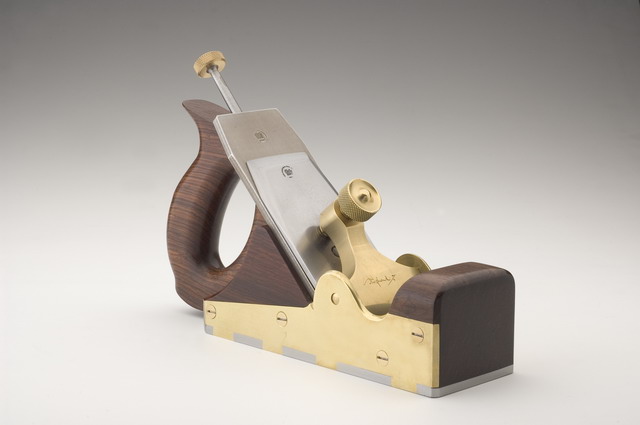
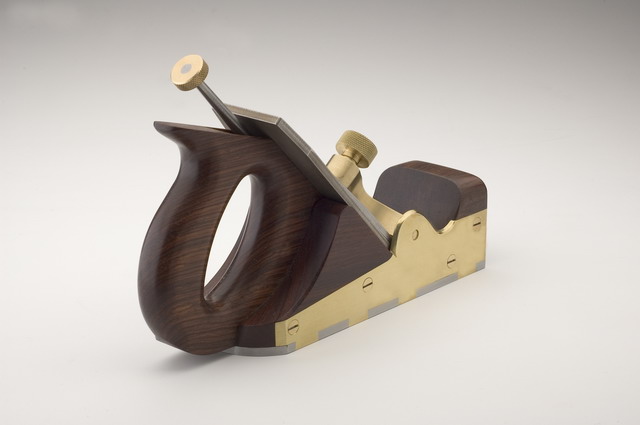
Tim Hawkins low-res photos
High resolution photographs available - email and ask.
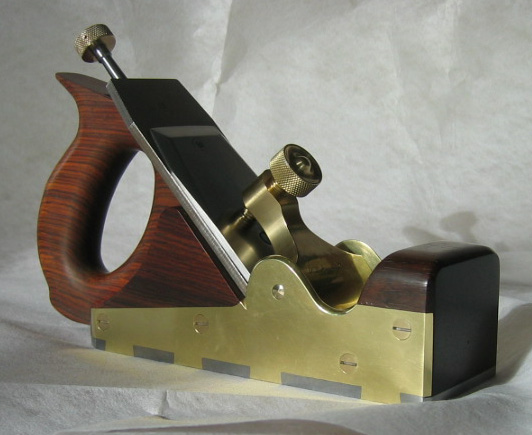
My 'kitchen table' photo.
This plane is now an historic curiosity. Shepherd Tools has gone out of business, and the kits are no longer available
A Mouse and a Chariot
Waiting for the Shepherd kit to arrive, I got in some practice by fabricating a small 'mouse' shaped infill low angle block plane, using some scrap quarter inch bright mild steel and a piece of rough brass bar scrounged from my local auto reconditioner. Uses a Hock iron, bevel up, and a captive nut in a wooden (lignum vitae) lever cap.
There was a fair bit of to-ing and fro-ing getting the Shepherd kit delivered. Eventually it turned up, accompanied by a Shepherd Chariot Plane kit, so as soon as the big smoother was finished, I made the Chariot. All steel (so doverails don't show), with a modified drop front and a recycled bronze nose (it's hardly a 'bun') shaped with an angle grinder and files/sandpaper. Parallel to the bottom, this configuration seems to connect me with the action of the blade, at about where it cuts. Infill and lever cap are quarter-sawn lignum vitae, from a piece that I've been carrying about for more than 20 years!
Made use of my signature features (screwed rather than peened, removeable lever pin, customisation to accentuate the shape).
Oh. The mouth! Impossibly tight! I can just see light, and it produces shavings! In the stuff I bought as part of a job lot of a tradesman's gear a couple of months ago was a tray full of fine little files, including one that was a very bare 1/16 thick. Ideal for achieving the mouth. I'd say the gap is about 1.5mm, and the aperture when the iron begins to cut is - genuinly - almost too small to see!
Here they are together
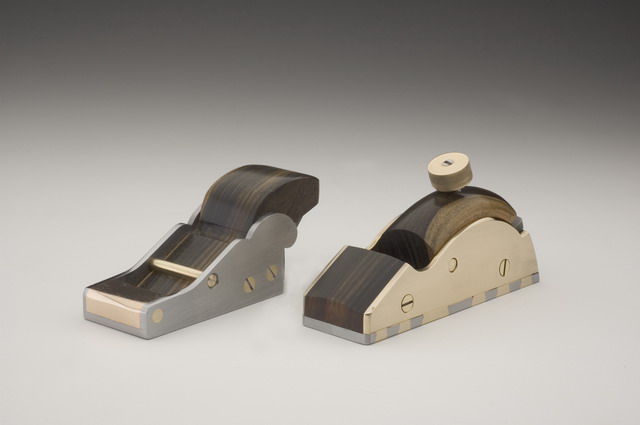
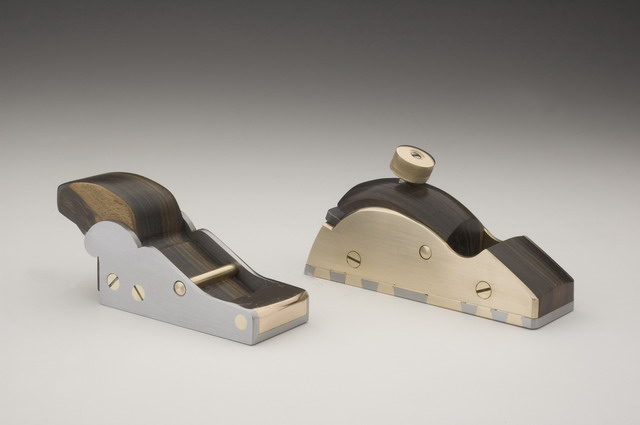
Tim Hawkins low-res photos
01 size infill
Next I made a small infill plane in a modified Scottish style, same size as a Stanley No 1 (6 and 5/8 inches long, by 1 and 5/8 wide, by 4 and 3/4 to the top of the adjuster), using a piece of 6mm stainless gauge plate for the sole and 5mm brass bar for the sides. York pitch (50 degrees) Lie-Nielsen iron and backiron, and a lever cap made by Philip Marcou. Infill is Australian desert acacia. The adjuster is a cut-down single-thread Norris-style, made by Classic Planes in the UK (a really international piece of work!)
Narrow pins are only 3mm wide (too narrow, won't do that again!). The 6mm (1/4 inch) stainless was quite hard to work, especially to small dimensions, but it does finish nice and bright, and should hold its finish.
The mouth is medium-width, about 0.4mm (say 3/64ths), which is twice the width of the mouth of the small sleigh-shaped plane, but about half the width of the mouth in the big smoother.
The dark chocolate-coloured acacia infill was nice to work - with unusual working properties (like ebony)- and takes a very satisfactory finish. I had to break the tote-piece apart and reglue with epoxy to deal with some splits.
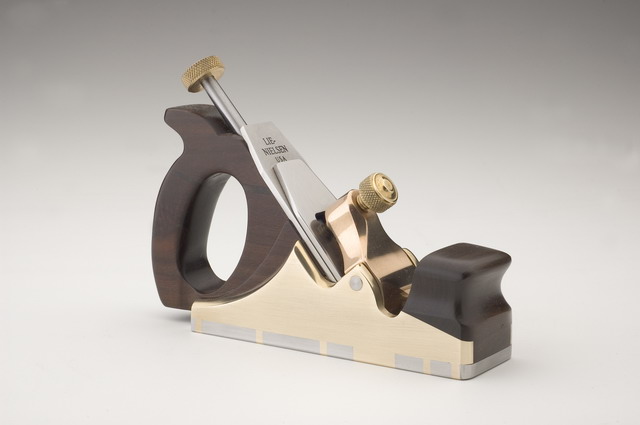
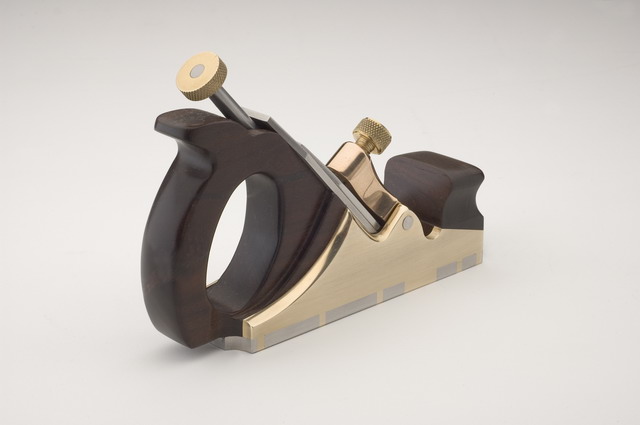
Tim's photos first, mine below

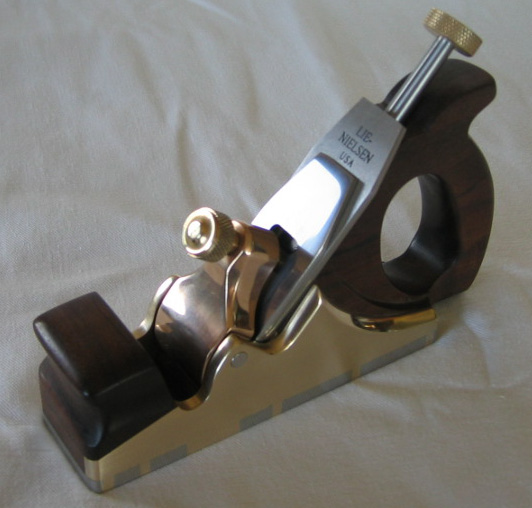
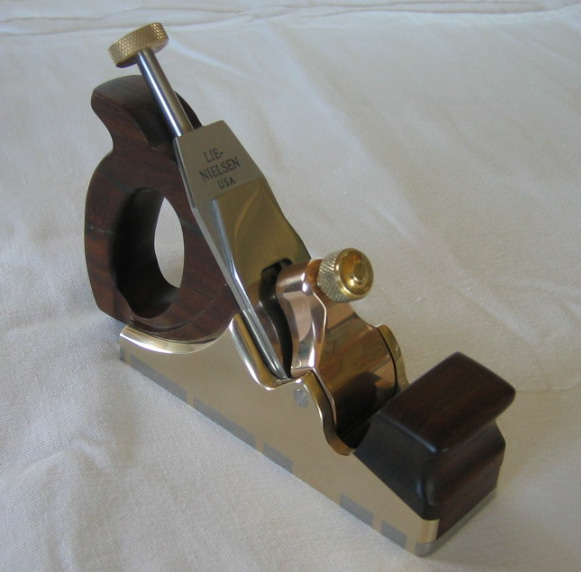
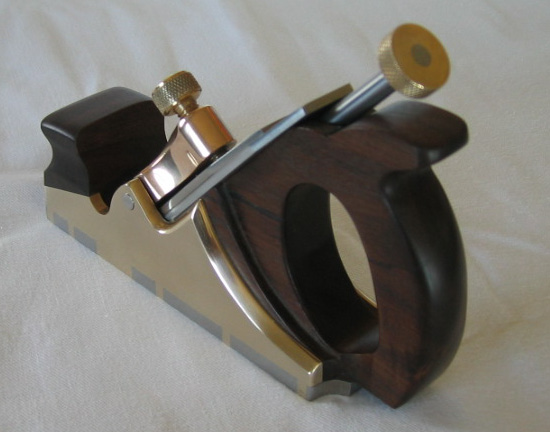
Here's my hand (sorry about the focus) to give scale. The rear tote (handle) is quite comfortable for a three-finger grip. Thumb to left, index finger pointing forward to the right - this is the traditional grip, even for full-size planes. This is my left hand!
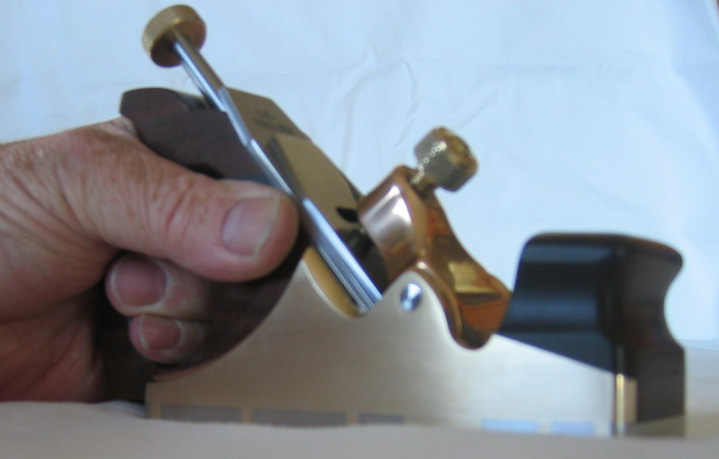
Next project - a chopper-inspired panel plane
Why 'chopper'? Long sweeping curves, extravagant engineering, OTT styling, customised to suit my hand grip and stance ...
300mm/12inches long, 2 and 5/8ths Clifton irons, recycled balloon knob, shop-made bronze lever cap with recycled threaded rod and a fine diamond-knurled knob made for me by Hayley's dad, 5mm gauge plate (steel) recycled 5mm brass, Indian rosewood infill (hand-carried from Australia - thanks Andrew).
Construction is conventional hand-cut dovetailing, with small pins wide-spread. The pedestal closed tote is screwed through the brass ramp extension and housed into the rear infill. The front knob is screwed to a 10mm threaded rod tapped into the front infill (so, if I grow to dislike it, it can be replaced).
The balloon knob seems large, but fits my left hand very well, and is comfortable to use.
This is a heavy tool, capable of 2.5 inch wide, whisper-thin shavings (the blade is very slightly crowned to avoid edge marks), but you wouldn't want to be pushing it all day!
Sole is flat - apparent curve caused by whiteboard backing sheet!
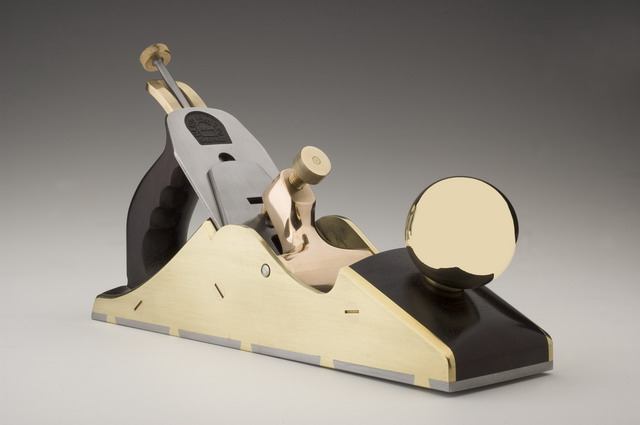
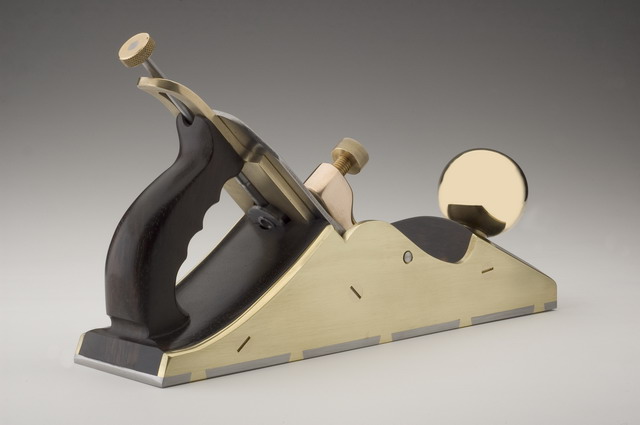
Tim's low-res photos above, mine below
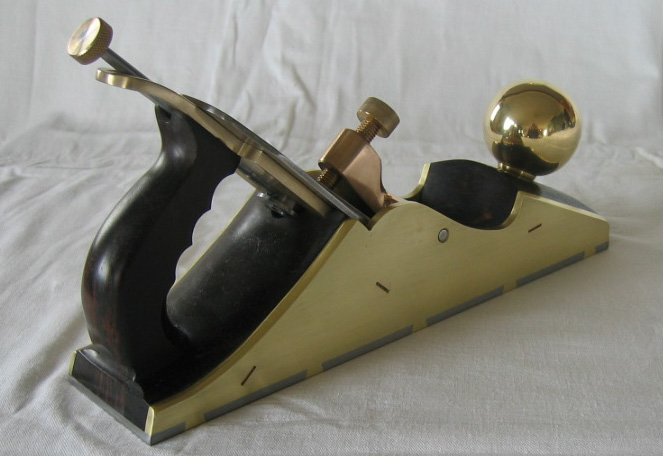
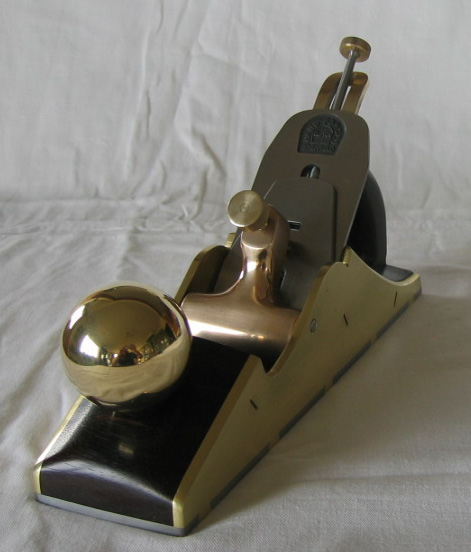


Art Deco concept plane
Stainless steel, brass, and Indian rosewood, Philip Marcou's bronze lever cap, Classic Planes' single-thread adjuster. Inverted pistol-grip pedestal-style open rear tote, made of two scales of rosewood riveted to a stainless steel spine. Barrel-shaped rosewood and brass laminated front bun, black perspex floor to the open front tunnel. Full-width 6mm brass ramp extends from the mouth to loop behind the adjuster.
Does it work? Visually, I think so.
The barrel-shaped front end also handles surprisingly well. First three fingers curl under the barrel, and the ball of the thumb snugs up to the smooth lever cap. The rear pistol-grip is customised to fit my right hand, and is very secure and comfortable. It's not fixed at the top end, and although made of 6mm steel, flexes perceptively when driven into the cut.
There's still work to do on this tool. I intend to fabricate a cover for the exposed adjuster mechanism, visible under the brass ramp, as soon as I can figure out how!
Overall, I think this is a promising idea ... and I'll come back to it later in the year. It's going to be a nice tool to use. The full-width brass bed for the 3/16 blade and the heavy Hock back-iron means that this tool functions as a heavy, well-damped smoother, with smooth, precise adjustment and considerable authority.
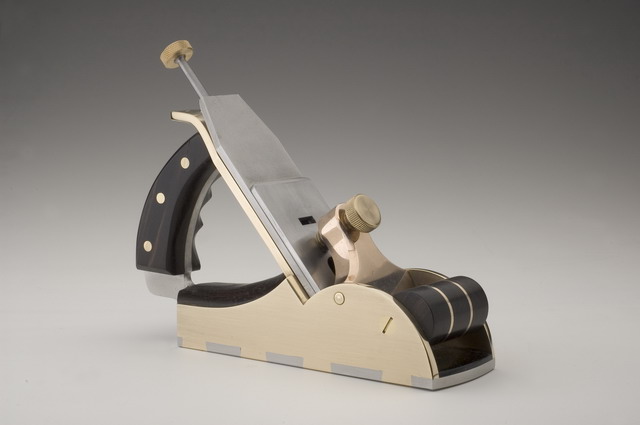

Tim's photos
Art Deco
The term Art Deco, coined in the 1960s, refers to a style that spanned the boom of the roaring 1920s and the bust of the Depression-ridden 1930s. Art Deco represented many things for many people.
It was the style of the flapper girl and the factory, the luxury ocean liner and the skyscraper, the fantasy world of Hollywood and the real world of the Harlem Renaissance. Art Deco affected all forms of design, from the fine and decorative arts to fashion, film, photography, transport and product design. It was modern and it was everywhere.
It drew on tradition and yet simultaneously celebrated the mechanized, modern world. Often deeply nationalistic, it spread like wild fire all over the world, dominating the skylines of cities from New York to Shanghai. It embraced both handcraft and machine production, exclusive works of high art and new products in affordable materials.
Art Deco reflected the plurality of the contemporary world. Unlike its functionalist sibling, Modernism, it responded to the human need for pleasure and escape. In celebrating the ephemeral, Art Deco succeeded in creating a mass style of permanence. Infinitely adaptable, it gave free reign to the imagination and celebrated the fantasies, fears and desires of people all over the world.
The Scorpion - a big little smoother
Steel gauge plate and brass, rosewood, shop-carved bronze lever cap, recycled half inch fine-pitch screw inlaid with sterling silver and abalone (paua in New Zealand). HNT Gordon iron, with a secondary screw to prevent the unbacked bevel-down iron from dropping through and chopping off toes when the cap is loosened!
This is probably the last (maybe second last) plane to be made this southern hemisphere summer (at 4th May), as the days shorten and the shop gets cold!
It set out to be an unhandled smoother, but at 3.6lbs was too heavy for unhandled use, so I chopped off some rosewood, ploughed-in a groove, and set in a brass and rosewood spine/tang to act as a rear tote.
Looks sort of aggressive, 'sporty' is a term used on Knots, and is real fun to use. The lever cap screw and sculpted cap act as a default front grip, in a surpisingly comfortable way, and it produces transparent full-width shavings with minimal push. These un-adjustered tools are very quick to set up - I do it by eye, not using a hammer (hate the idea of whacking, even politely, into tools made with high standards of finish).





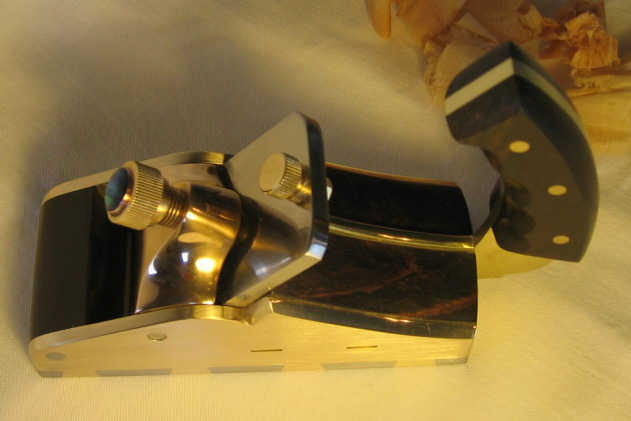
My photos this time - completion of this project happened after the photo session